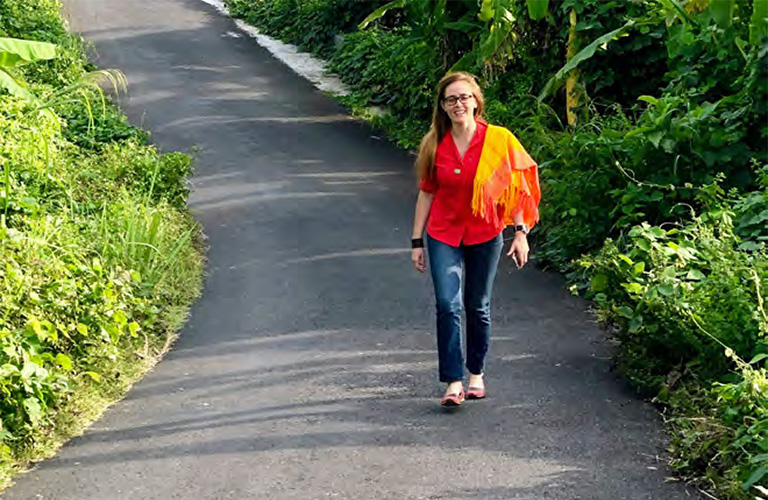Tea stalls and hard talk

Channeling the power of youth in low-income urban settlements
March 24, 2019
Can play save a displaced generation?
April 1, 2019Tea stalls and hard talk

Engaging men and boys in the Rohingya camps in Cox’s Bazar in the prevention of sexual and gender-based violence
Perched on a hilltop in Chakmarkul, Teknaf, a makeshift stall selling snacks and tea plays impromptu host to a group of young men. The narrow seating area is shaded from the midday sun by a thatched bamboo and tarp cover. One side overlooks a verdant green landscape. On the other side a sprawling mass of settlements that many of the tea stall participants currently call home stretch out as far as the eye can see.
There are no cups of tea at this gathering. Instead, tea stalls are a convenient place in the densely populated camps to raise awareness about the pressing protection issues that concern the men and boys who frequent them.
Two BRAC staff members, dressed in magenta pink staff vests and baseball caps, facilitate a discussion on child, early and forced marriage. Nine adolescent boys, in their late teens, lean in on low plastic stools to listen to the social and health implications if they get married and get women pregnant at a young age.
The tea stall owner seems unperturbed that no one is buying his goods as he listens in as well. Passers-by, mostly older men or younger boys, peer in or linger for a while before moving on with their day. It is a curious conversation for all.

Rising rates of child early and forced marriage
Decades of persecution by the Myanmar military has seen the Rohingya community adopt child marriage as a strategy to prevent girls from being raped by the army. The rationale is that if a girl who reaches puberty is married and gets pregnant immediately, she will not be a target for soldiers. If a girl is raped before she is married, it will be harder to find her a husband as she will be considered ‘damaged good’ by her own community. Stigma about rape is deep-rooted.
In November 2017, Human Rights Watch highlighted the hundreds of reported cases of sexual violence against Rohingya women and girls before they fled Myanmar last year. The main barrier interviewees gave for not reporting rape or seeking healthcare, despite experiencing severe pain, was stigma and shame. It is common to prevent women and girls from openly talking about rape.
Child marriage is often a response to the fear of sexual assault and harassment in the densely populated and mostly poorly-lit camps. Families, as many as 16 per cent headed by vulnerable single mothers, have had to make shelters among strangers. The threat of trafficking is high.
This confines women and in particular adolescent girls, within their shelters, despite the stifling heat. Cultural and religious practices about female modesty and purdah (the practice of screening women from men or strangers) means they cannot even leave their home to use the bathroom without wearing a burqa. These garments are in short supply, and often have to be shared by female household members.
A study by Plan International on the experiences of adolescent girls in the camps in April 2018 revealed that one of the most pressing challenges they face is the lack of freedom of movement. Unlike men and boys, many are not at liberty to roam the camps, access services without permission from the head of the household, or spend their spare time sitting in tea stalls.
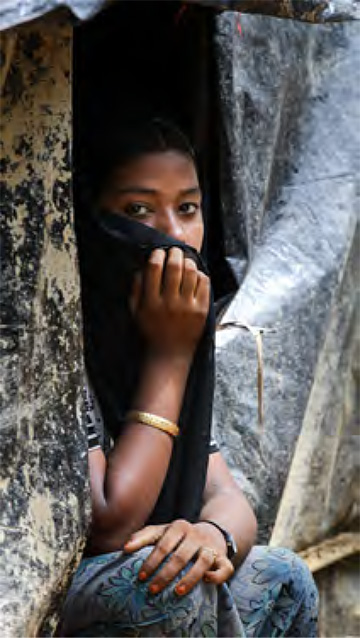
There are 5 per cent more women than men aged 18-59 years old in the camps.
Humanitarian agencies are concerned that child marriage is being used as a harmful coping mechanism by families to access additional food rations. Ration cards are distributed per household, and families have been known to separate, or claim they are separated, to ward off food insecurity. A married couple can be put forward as a different household.
Polygamy as a coping mechanism
Polygamy, or more specifically polygyny, where a man has two or more wives, is also rising. The practice is culturally accepted among Rohingya Muslims, as Islamic marital jurisprudence allows a man to take up to four wives. The practice has increased due to the scarcity of men in the community, however.
Significant numbers of Rohingya men were killed by the military in Myanmar in the latest attacks. Surveys carried out by Médecins Sans Frontières (MSF) in November 2017 conservatively estimated that 75 per cent of the 6,700 Rohingyas killed due to violence were male. An undetermined number of men have also migrated beyond the settlements in Cox’s Bazar in search of livelihood opportunities.
The predicament with polygyny in the camps is that, instead of treating all wives equally as Islam prescribes, Rohingya men are abandoning their existing wives, who often have large families and small children to take care of. They set up homes with their new brides, leaving the former to fend for themselves with a multitude of daily tasks in hazardous conditions, from collecting firewood and water to rain-proofing their shelters.
Polygyny has been classified by workers in the aid sector as gender-based violence, as a result of the disruption it is causing within families suffering from trauma.
Marriage: An easier prospect
The tea stall owner interjects to give his understanding of why the rate of marriage has increased in the camps. In Myanmar, the process was made difficult for the Rohingya by the authorities. Before getting married, they had to submit a form at the marriage registration office, pay a sizeable fee, and wait for approval. In the camps, families do not need to go through these strict legal procedures and costs. In fact, due to their lack of recognised legal status, Rohingyas cannot have births, marriages or deaths legally registered in Bangladesh.
The marriage takes place under a religious ceremony, and the groom’s family demands a dowry from the bride’s, even though Islamic law does not permit dowries. The BRAC staff discuss this cultural and religious contradiction with the boys in their group, and whether it is fair for women and girls and their families.
Domestic and intimate partner violence: Also on the rise
The conversation switches to domestic and intimate partner violence, which is a rising concern in this protracted and highly stressful situation. One of the boys in the group does not grasp what the dilemma is. “Surely it is okay to beat your wife?” he asks.
The BRAC staff shake their heads in dismay. Before starting the discussion, they had appointed a role model from the Rohingya community to help reinforce their messages against sexual and gender-based violence (SGBV). They turn to him for support.
“It’s gunah,” he says, using the Arabic word for ‘sin’, and appealing to the Islamic faith of his peers. Together with the BRAC staff, he explains why it is not acceptable to be physically or psychologically abusive towards family members, or to anyone for that matter.
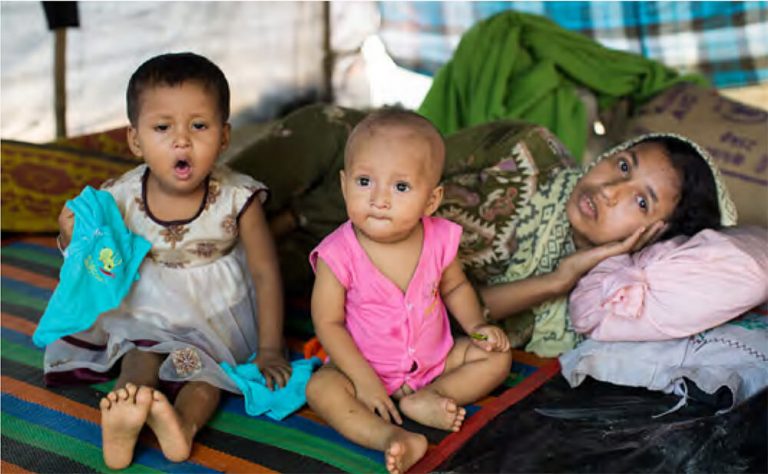
Protection: A crisis within a crisis
The Rohingya crisis is at its core a protection crisis, states the humanitarian community Joint Response Plan for 2018, led by the Inter-Sector Coordination Group in Cox’s Bazar. From the atrocities in Myanmar to talks of relocation in Bangladesh, to the ultimate question of repatriation, the rights and wellbeing of Rohingya women, men, girls and boys, must be protected. Root causes need to be addressed and comprehensive solutions found.
A major focus of BRAC’s sexual and gender-based violence work has been on setting up women friendly spaces. Over time, these have come to be known as ‘shanti khana’, meaning ‘peaceful house’ in both Bangla and the Rohingya language. They are places where women and adolescent girls can access legal case management, guidance, referrals and counselling support.
“Women and adolescent girls were asked what they want to do in these spaces,” explains Tahmina Yeasmin, who is leading BRAC’s protection programme in Cox’s Bazar of the two-way dialogue they have developed with the Rohingya community.
“They expressed interest in embroidery, painting, having the newspaper read to them so that they can keep up-to-date on their situation. They wanted a safe space to spend time with their children, or find a spot to sleep away from their own shelter.”
Handicraft, tailoring, drawing and newspaper reading now form part of the daily activities in the women friendly spaces. “Creative and informative activities, and talking to one another help to heal the psychosocial damage they have been through,” says Yeasmin.
So far, BRAC staff have provided 112,215 psychosocial support sessions. Leadership sessions have also been provided to women to help them make decisions that concern them and their children.
Exposing new vulnerabilities
Earlier this year, given the unfolding sexual and gender-based violence issues, BRAC added a new component to its SGBV portfolio. Recognising the different roles that men and boys can play in these problems and their solutions, and the fact that many perpetrators are in need of assistance themselves, BRAC, together with UNHCR, initiated a programme to engage men and boys in sexual and gender-based violence prevention and response.
The aims of the initiative are two-fold, as Samsad Asad Khan, senior protection assistant (SGBV) at UNHCR, outlines, “Our objectives for engaging men and boys is to reduce violence in the Rohingya community, and to provide equitable access to services for male survivors of violence.”
Shakh Jahidur Rahman, a men and boys engagement manager at BRAC, adds, “To make a concrete and sustainable sexual and gender-based violence programme, engaging men and boys is essential, as they can be perpetrators, survivors, and agents of change.”

Pledging to never commit, condone or remain silent
Engaging men and boys has, in the past decade or so, emerged as a vital strategy for ending gender-based violence in crisis settings. BRAC has been increasing the participation of men and boys in preventing violence against women, as part of its gender equality and community empowerment work, for a number of years.
With permission from UNHCR, BRAC invited an expert in sexual and gender-based violence, Suhail Abualsameed, with experience of working in displacement contexts in Jordan, Kenya and Greece, to design a tailored intervention in Cox’s Bazar.
A situation assessment was carried out in April 2018, which included focus group discussions and one-to-one interviews with majhis (camp leaders), imams (religious leaders), a cross-section of Rohingya boys, parents, young adults, men and women, and frontline staff.
The assessment found that there were a lack of programmes targeting men and boys in the camps, although actors in the sector acknowledged that the need for such efforts are great. Initial outreach work by BRAC’s Community Based Protection community outreach members revealed worrying anecdotal evidence of sexual and gender-based violence against men and boys both pre-displacement in Myanmar, and within the camps.
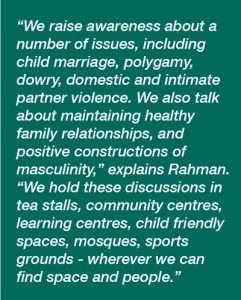
Another opportunity the assessment identified is that the stakeholders showed an interest in engaging and learning. The focus group discussions and capacity building sessions provide a chance to break the monotony of everyday life in the camps, and a space for social interaction. As a result, the community-based awareness-raising discussions, such as the tea stall conversations, play a significant feature in this outreach programme.
Other activities to engage men and boys include rapport building through sports and games. Before launching into these difficult debates, staff invest time to get to know the community and gain their trust. Sports and games help them to break the ice, and over time, speak to young men and boys about the harmful norms of masculinity and their impacts on the lives of women and girls and their own lives.
Seventy-six men and boys groups have been set up so far, each comprising of 6-20 similarly aged members, to work with on these activities, with a view to increasing this significantly in 2019. Group members are encouraged to speak out against violence, and contribute to developing positive ideas about masculinity among their friends.
125 role models have also been identified from the Rohingya community, who demonstrate a positive attitude towards the issues discussed, and have the ability to be an agent of change. In order to diversify leadership within the camps, role models cannot be majhis, although having imams in this position is helpful.
One of the challenges the situation assessment highlighted is that in the absence of education and media outlets, imams can often be the only source of learning and information for the Rohingya community. Many of the imams hold very conservative interpretations of Islam, and can present a barrier towards the change the programme seeks to achieve.
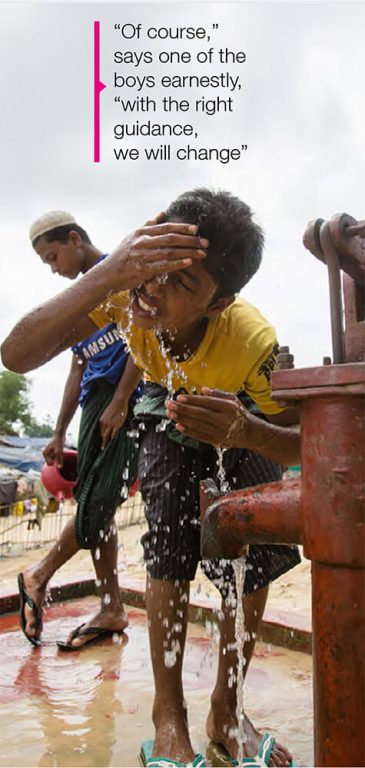
Initial sensitisation activities were held with imams by Abualsameed, and there are future plans to run more of these, with imams and mahjis, in partnership with Islamic Foundation. Rather than working against religion, and its associated risks of radicalisation, the programme endeavours to work with the tools of resilience and healing it can bring.
Another challenge the assessment mentioned is the lack of experience frontline staff have in tackling violence and working in humanitarian settings. In connection to this, there is a risk that the activities could trigger traumatic reactions from participants, and that the specialised mental health support services needed are few and far between. Abualsameed ran a four-day training for BRAC programme organisers, covering the principles of SGBV and engaging men and boys, and co-created the programme strategy and work plan with them and BRAC staff. In addition, they received sessions on male engagement from UNHCR, and psychosocial first aid from BRAC.
The programme organisers for this initiative are male, aged 24-30 years, and recruited from the host community. They can communicate in the local Chittagong dialect, which is similar to the Rohingya language, as well as in Bangla and English. They generally have Bachelor’s and Master’s degrees, given the myriad of complexities and sensitivities the programme tackles. Each of the programme organisers is responsible for overseeing of the men and boys’ groups, supporting the role models, and facilitating awareness raising discussions each week.
To date, 18,642 men and boys have been reached through community-based and sports and games interventions. The programme’s ambition to work towards ensuring equitable access to services for male survivors of SGBV is harder to achieve, points out Rahman, due to the dearth of service providers working in this space.
“The other challenge,” continues Rahman, “is engaging men and boys in a programme that does not develop their skills per se, or lead to education or employment opportunities”. The young men at the tea stall are bored in the camps. Other than collecting food rations and carrying them home, there is little else for them to do. They don’t even have a football pitch here in Chakmarkul, Camp 21 out of 32.
Back home, they used to go to school, and play football in their spare time. Some studied up to Class 9 or 10, and wanted to continue with their studies. Those that worked were involved in farming or fishing in the land they had to leave behind on the other side of the Naf River.
They are interested in learning computer skills or mechanics in the camps, to help them earn money when they return. However, there is no humanitarian response budget for formal education or youth development, and adolescent boys and girls are in particular danger of becoming a ‘lost generation’.
Alcohol and drug abuse are also said to be increasing among men and boys as they grapple with the horrors they have seen and the stress of not having the means to support their families.
The conversation turns to eve-teasing, or public sexual harassment of women and girls. A couple of the boys’ snigger and suggest this is normal. They catch themselves as the BRAC programme organisers look at them sternly, and their peers turn away, shamefaced. “Of course,” says one of the boys earnestly, “with the right guidance, we will change.”
Jebi Rahman is an international and sustainable development consultant, and has previously worked with BRAC UK.

